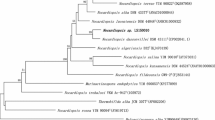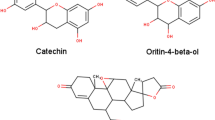Abstract
With the anti-microbial and anti-tumor composite screening model, bioassay-guided fractionation led to the isolation of two structurally related bioactive compounds, curvularin and αβ-dehydrocurvularin, from ethyl acetate extract of Eupenicillium sp. associated with marine sponge Axinella sp. Further study on the structure–activity relationship demonstrated that both compounds exhibited differences in bioactive profiles which are highly associated with their minor structural differences. Both curvularin and αβ-dehydrocurvularin have similar level of anti-fungal and anti-tumorous activity, while αβ-dehydrocurvularin is active against Staphylococcus aureus with a minimal inhibitory concentration of 375 μg/ml but curvularin does not. No detectable activity against Gram-negative bacteria such as Escherichia coli and Pseudomonas aeruginosa exists for both compounds. It is suggested that the partial planar backbone structure, due to the conjugation of π electrons in the presence of a 3,4-double bond and the carbonyl group at position C-2 in αβ-dehydrocurvularin, acts as a key factor for the inhibition of S. aureus, a Gram-positive low G + C bacteria that are often the hospital-acquired and/or community-acquired pathogen.


Similar content being viewed by others
References
Robeson, D. J., & Strobel, G. A. (1981). αβ-Dehydrocurvularin and curvularin from Alternaria cinerariae. Zeitschrift fur Naturforschung C—A Journal of Biosciences, 36(11–1), 1081–1083.
Kusano, M., Nakagami, K., Fujioka, S., Kawano, T., Shimada, A., & Kimura, Y. (2003). βγ-Dehydrocurvularin and related compounds as nematicides of Pratylenchus penetrans from the fungus Aspergillus sp. Bioscience, Biotechnology, and Biochemistry, 67(6), 1413–1416. doi:10.1271/bbb.67.1413.
Ghisalberti, E. L., Hockless, D. C. R., Rowland, C. Y., & White, A. H. (1993). Structural study of curvularin, a cell division inhibitor. Australian Journal of Chemistry, 46(4), 571–575.
Almassi, F., Ghisalberti, E. L., Skelton, B. W., & White, A. H. (1994). Structural study of dehydrocurvularin, an inhibitor of microtubule assembly. Australian Journal of Chemistry, 47(6), 1193–1197.
Kobayashi, A., Hino, T., Yata, S., Itoh, T. J., Sato, H., & Kawazu, K. (1988). Unique spindle poisons, curvularin and its derivates, isolated from Penicillium species. Agricultural and Biological Chemistry, 52(12), 3119–3123.
Coombe, R. G., Jacobs, J. J., & Watson, T. R. (1968). Constituents of some Curvularia species. Australian Journal of Chemistry, 21(3), 783–788.
Caputo, O., & Viola, F. (1977). Isolation of αβ-dehydrocurvularin from Aspergillus aureofulgens. Planta Medica, 31(1), 31–32. doi:10.1055/s-0028-1097485.
Arai, K., Rawlings, B. J., Yoshizawa, Y., & Vederas, J. C. (1989). Biosynthesis of antibiotic A26771B by Penicillium turbatum and dehydrocurvularin by Alternaria cinerariae: comparison of stereochemistry of polyketide and fatty acid enoyl thiol ester reductases. Journal of the American Chemical Society, 111(9), 3391–3399. doi:10.1021/ja00191a042.
Zhan, J. X., Wijeratne, E. M. K., Seliga, C. J., Zhang, J., Pierson, E. E., Pierson, L. S., et al. (2004). A new anthraquinone and cytotoxic curvularins of a Penicillium sp. from the rhizosphere of Fallugia paradoxa of the Sonoran desert. The Journal of Antibiotics, 57(5), 341–344.
Schoenborn, L., Yates, P. S., Grinton, B. E., Hugenholtz, P., & Janssen, P. H. (2004). Liquid serial dilution is inferior to solid media for isolation of cultures representative of the phylum-level diversity of soil bacteria. Applied and Environmental Microbiology, 70(7), 4363–4366. doi:10.1128/AEM.70.7.4363-4366.2004.
Nag Raj, T. R. (1995). What is Myrothecium prestonii. Mycotaxon, 53, 295–310.
Manwar, A., Khandelwal, S., Chaudhari, B., Meyer, J., & Chincholkar, S. (2004). Siderophore production by a marine Pseudomonas aeruginosa and its antagonistic action against phytopathogenic fungi. Applied Biochemistry and Biotechnology, 118(1–3), 243–251. doi:10.1385/ABAB:118:1-3:243.
de Beer, E. J., & Sherwood, M. B. (1945). The paper-disc agar-plate method for the assay of antibiotic substances. Journal of Bacteriology, 50(4), 459–467.
Pass, D. M., Foley, W. J., & Bowden, B. (1998). Vertebrate herbivory on Eucalyptus—identification of specific feeding deterrents for common ringtail possums (Pseudocheirus peregrinus) by bioassay-guided fractionation of Eucalyptus ovata foliage. Journal of Chemical Ecology, 24(9), 1513–1527. doi:10.1023/A:1020911800847.
Ter Laak, E. A., Pijpers, A., Noordergraaf, J. H., Schoevers, E. C., & Verheijden, J. H. (1991). Comparison of methods for in vitro testing of susceptibility of porcine Mycoplasma species to antimicrobial agents. Antimicrobial Agents and Chemotherapy, 35(2), 228–233.
Denizot, F., & Lang, R. (1986). Rapid colorimetric assay for cell growth and survival modifications to the tetrazolium dye procedure giving improved sensitivity and reliability. Journal of Immunological Methods, 89(2), 271–275. doi:10.1016/0022-1759(86)90368-6.
Musgrave O. C. (1957). Curvularin. 2. The constitution of an aromatic degradation product and the partial structure of curvularin. Journal of the Chemical Society, (3), 1104–1108.
Munro, H. D., Musgrave, O. C., & Templeton, R. (1976). Curvularin. Part V. The compound C16H18O5, αβ-dehydrocurvularin. Journal of the Chemical Society C—Organic, (10), 947–948.
Aragi, Y., Taga, N., & Simidu, U. (1977). Isolation and distribution of oligotrophic marine bacteria. Canadian Journal of Microbiology, 23(8), 981–987.
Kuznetsov, S. I., Dubinina, G. A., & Lapteva, N. A. (1979). Biology of oligotrophic bacteria. Annual Review of Microbiology, 33, 377–387. doi:10.1146/annurev.mi.33.100179.002113.
Durand, M. L., Calderwood, S. B., Weber, D. J., Miller, S. I., Southwick, F. S., Caviness Jr, V. S., et al. (1993). Acute bacterial meningitis in adults: a review of 493 episodes. The New England Journal of Medicine, 328(1), 21–28. doi:10.1056/NEJM199301073280104.
Moreillon, P. (2008). New and emerging treatment of Staphylococcus aureus infections in the hospital setting. Clinical Microbiology and Infection, 14, 32–41. doi:10.1111/j.1469-0691.2008.01961.x.
Zhang, S. Z., Yang, X. N., Coburn, R. A., & Morris, M. E. (2005). Structure activity relationships and quantitative structure activity relationships for the flavonoid-mediated inhibition of breast cancer resistance protein. Biochemical Pharmacology, 70(4), 627–639. doi:10.1016/j.bcp.2005.05.017.
Dizhbite, T., Telysheva, G., Jurkjane, V., & Viesturs, U. (2004). Characterization of the radical scavenging activity of lignins—natural antioxidants. Bioresource Technology, 95(3), 309–317. doi:10.1016/j.biortech.2004.02.024.
González-Díaz, H., Olazábal, E., Santana, L., Uriarte, E., González-Díaz, Y., & Castañedob, N. (2007). QSAR study of anticoccidial activity for diverse chemical compounds: prediction and experimental assay of trans-2-(2-nitrovinyl)furan. Bioorganic & Medicinal Chemistry, 15(2), 962–968. doi:10.1016/j.bmc.2006.10.032.
Cheng, S. S., Liu, J. Y., Chang, E. H., & Chang, S. T. (2008). Antifungal activity of cinnamaldehyde and eugenol congeners against wood-rot fungi. Bioresource Technology, 99(11), 5145–5149. doi:10.1016/j.biortech.2007.09.013.
Kojima, M. K., Takakuwa, T., Nakamura, S., & Kobayashi, A. (1986). Effects of curvularin, the mold metabolite, on cleavage in sea-urchin eggs. Cell Structure and Function, 11(4), 476–476.
Yao, Y., Hausding, M., Erkel, G., Anke, T., Forstermann, U., & Kleinert, H. (2003). Sporogen, S14–95, and S-curvularin, three inhibitors of human inducible nitric-oxide synthase expression isolated from fungi. Molecular Pharmacology, 63(2), 383–391. doi:10.1124/mol.63.2.383.
Acknowledgements
This research was partially funded by the Knowledge Innovation Program of the Chinese Academy of Sciences (KZCX2-YW-216, KZCX2-YW-211) and National Supportive Plan Project of Science and Technology (2006BAB19B02). Parts of this study were carried out at the Key Laboratory of Microbial Application and Innovative Technology of Guangdong Province as an open funding project. We also thank the financial support of the Hundred Talents Program of Chinese Academy of Sciences. Many thanks to Dr. K. J. Lee for identification of the marine sponge, to Prof. Zanmin Hu and Prof. Honghui Zhu for providing some of the indicator organisms, and to Dr. Donna Smith for critical reading of this manuscript.
Author information
Authors and Affiliations
Corresponding author
Additional information
Lian Wu Xie and Yong Chang Ouyang contributed equally to this work.
Rights and permissions
About this article
Cite this article
Xie, L.W., Ouyang, Y.C., Zou, K. et al. Isolation and Difference in Anti-Staphylococcus aureus Bioactivity of Curvularin Derivates from Fungus Eupenicillium sp.. Appl Biochem Biotechnol 159, 284–293 (2009). https://doi.org/10.1007/s12010-009-8591-2
Received:
Accepted:
Published:
Issue Date:
DOI: https://doi.org/10.1007/s12010-009-8591-2




